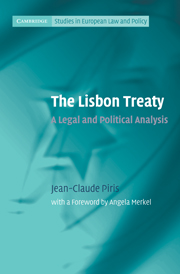Book contents
- Frontmatter
- Contents
- List of boxes
- Foreword by Angela Merkel, Chancellor of the Federal Republic of Germany
- Acknowledgements
- Table of cases
- List of abbreviations
- Introduction
- I The origins and birth of the Lisbon Treaty
- II General provisions
- III Democracy
- IV Fundamental Rights
- V Freedom, Security and Justice
- VI Institutions
- VII External affairs
- VIII Financial, economic, social and other internal affairs
- Conclusion: the Lisbon Treaty and beyond
- Appendixes
- References
- Index
- References
Introduction
Published online by Cambridge University Press: 05 June 2012
- Frontmatter
- Contents
- List of boxes
- Foreword by Angela Merkel, Chancellor of the Federal Republic of Germany
- Acknowledgements
- Table of cases
- List of abbreviations
- Introduction
- I The origins and birth of the Lisbon Treaty
- II General provisions
- III Democracy
- IV Fundamental Rights
- V Freedom, Security and Justice
- VI Institutions
- VII External affairs
- VIII Financial, economic, social and other internal affairs
- Conclusion: the Lisbon Treaty and beyond
- Appendixes
- References
- Index
- References
Summary
May and June 2005: the peoples of two of the six founding members of the European Union, France and the Netherlands, consulted by referendum, refuse to ratify the Constitutional Treaty for Europe.
June 2008: the people of Ireland, one of the countries which has benefited most from the European Union, rejects the ratification of the Lisbon Treaty.
What is happening?
Does this mean that the dreams of a reconciled and more united Europe are dying? What exactly are those dreams? And, to begin with, which countries and peoples are concerned?
It is not easy to give a definition of Europe, whether geographically, historically or culturally.
Geographically, Europe is not a precise concept. It is not a continent, but rather a peninsula at the western edge of the Eurasian continent. Its eastern borders are far from being precise. It presents a vast variety of landscapes and climates, from the driest places of its Mediterranean coasts to the polar regions of Lapland.
It has always been populated by many diverse peoples, mainly but not only Christians, using dozens of languages and even different alphabets.
Historically, these peoples have organised themselves into national entities, according to their religions, languages or geographical situation. Over the centuries, Europeans have developed and strengthened the concept of the nation state. The European nation states have nurtured their differences, thus favouring nationalism, something which often led to wars with their neighbours. Nationalism explains why European nations have been fighting each other over the centuries.
Information
- Type
- Chapter
- Information
- The Lisbon TreatyA Legal and Political Analysis, pp. 1 - 6Publisher: Cambridge University PressPrint publication year: 2010
